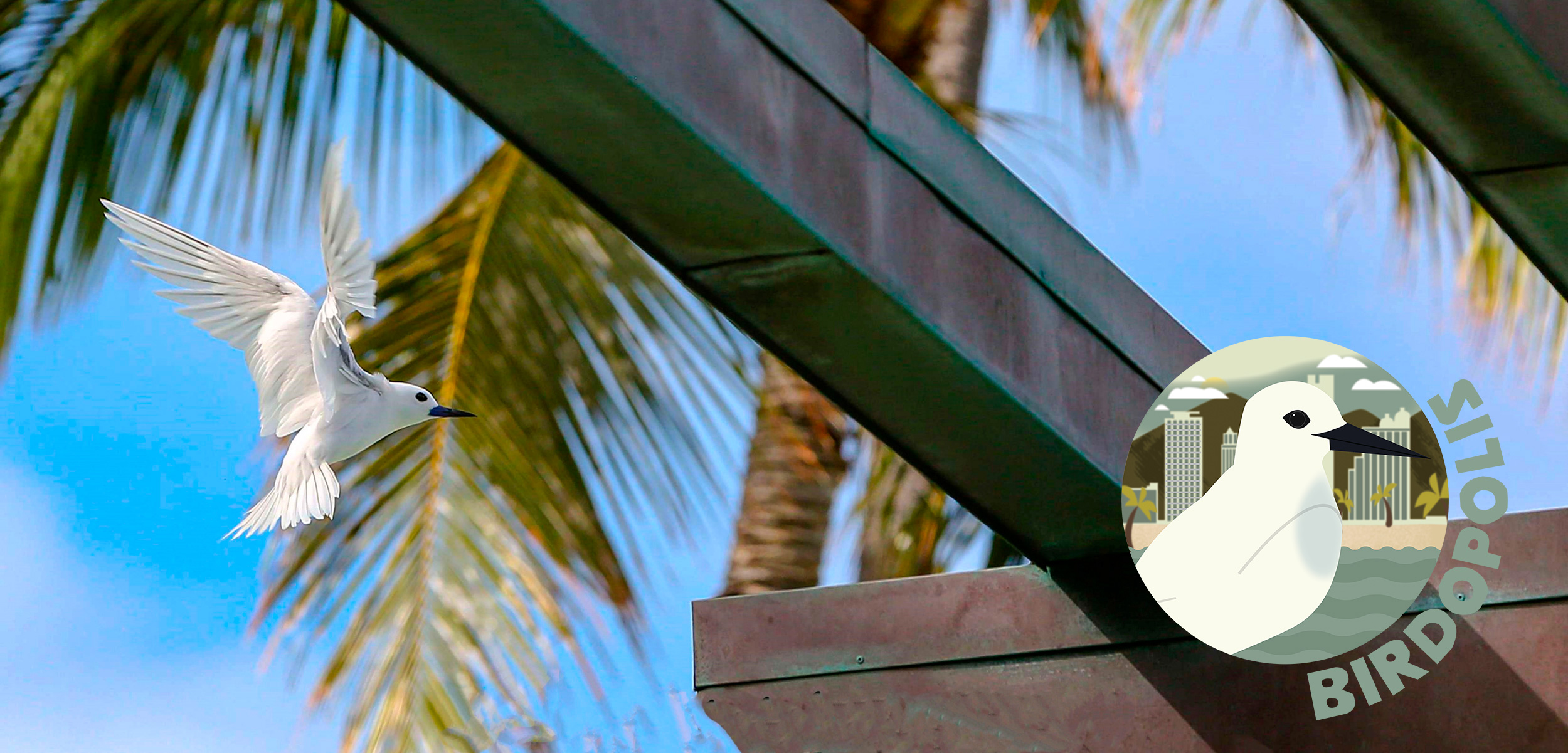Honolulu: A Seabird’s Surprising Five-Star Destination
The white tern—Manu-o-Kū—has excited ornithologists, its population growing within the busiest of Hawai‘i’s urban landscapes.
Article body copy
This article is part of Birdopolis, a three-part series that explores the lives of birds that are, by accident or design, spending more time in urban environments. The others are “The Gull Next Door” and “The City, the Sparrow, and the Tempestuous Sea”.
For insights into the urban lives of another group of coastal birds—gulls—watch the recording of our webinar “Birdopolis: Coastal Birds at Home in the City.”
It’s nearly 11:00 on a drizzly January 2020 morning on the University of Hawai‘i campus in Honolulu, O‘ahu, and 67-year-old birder Rich Downs is making himself a curiosity again. For three hours, he has moved from tree to tree, zigzagging on busy sidewalks with a singular data-collecting focus—looking up into branches with binoculars, typing information into his tablet, taking photos, and occasionally tying blue ribbons marked with the number for a wildlife hotline around seemingly random tree trunks. Dozens of college students stream past Downs; some rubberneck up at the branches as they pass. If they see the small white bird Downs is so eagerly documenting, they’re not intrigued enough to delay their migrations to and from class. Only one student pauses: “It’s turning into a Manu-o-Kū haven in here,” he says, using the Hawaiian name for the bird.
Those are sweet words to Downs, who quickly explains how he’s documenting sightings, and how the student can, too, before the young man hurries on.

Amateur ornithologist Rich Downs flags a tree used by nesting white terns at a University of Hawai‘i campus in Honolulu, Hawai‘i.
The majority of the 80,000 or so white terns in the Hawaiian archipelago breed far from here, on the sparsely populated, remote islands of Papahānaumokuākea Marine National Monument, in the northwestern part of the chain. They crowd into the refuge with roughly six million other breeding birds of 22 species. Far fewer seabirds nest in the main Hawaiian Islands, the larger landmasses in the south, such as O‘ahu, that are also most packed with people. A mere 550,000 breeding birds of 18 species—many of them in decline—can be found in the main islands.
The white tern, or Manu-o-Kū, is a rarity among them—a native seabird that is doing well in an urban setting. Throughout the main islands, people have destroyed much of the native habitat that seabirds could have used for nesting and introduced invasive mammalian predators including rats, cats, mongooses, and pigs. Those changes have driven most seabirds in the region to small pockets of existence at high elevations, on predator-free offshore islets, and in places with predator controls such as fencing and trapping.
White terns on the main islands have, for some reason, avoided those safer areas and appeared smack dab in the heart of Honolulu, the state’s biggest and busiest metropolitan area. This development is a rare spot of hope for conservationists. Human habitation has proved categorically bad for seabirds in general. As the white tern defies the odds and grows its Honolulu population, a community desperate to welcome a little wilderness back to its city streets rallies behind it.
The white tern is a slight and elegant seabird with stark white feathers, a sharp black-and-blue bill, and jet black eyes. Its body size is about the same as an American robin’s, but it has a wingspan of almost a meter. Like most seabirds, it may spend months or more at sea, only coming ashore periodically throughout the year to lay eggs on cliffside nubs or tree branches often just several centimeters wide. Little is known about how far white terns travel or for exactly how long, though recently recorded flights indicate some may migrate 2,000 kilometers in the non-breeding season.
Beyond Hawai‘i, white terns nest on small, remote islands in the Indian, South Atlantic, and Pacific Oceans. Global population estimates indicate there are at least 200,000 birds, but that number is a rough approximation, as bird counts in many of these far-flung habitats are rare or nonexistent.
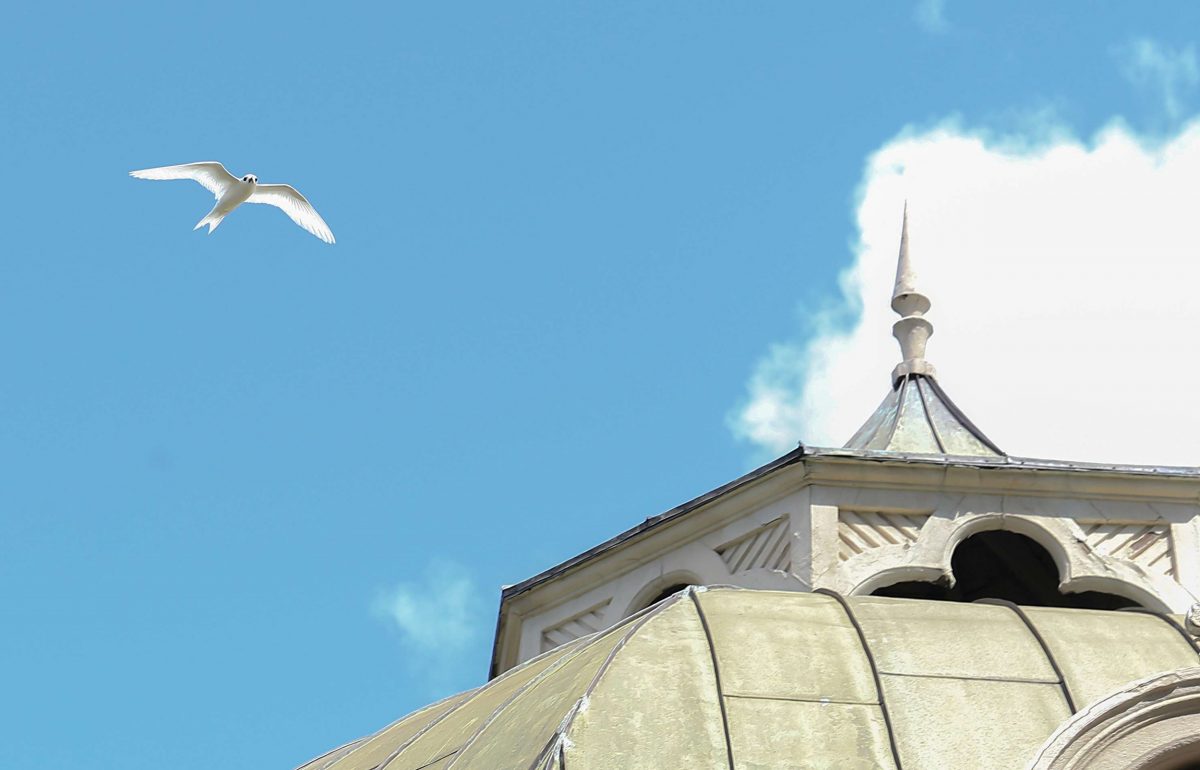
A white tern soars over a gazebo at the Iolani Palace in Honolulu, once the residence of the monarchy.
It’s unclear if white terns lived on the main Hawaiian Islands historically, before humans and the predators they towed along from Polynesia and Europe landed—no fossils of their delicate bones have been found—yet scientists suspect they did. The first nesting pair of white terns recorded on the main Hawaiian Islands was found in 1961 at Honolulu’s Koko Head area. The population of breeding birds in the city went from an estimated 200 in the 1980s to more than 2,200 recently, a dramatic increase.
Genetic analysis indicates that some of Honolulu’s white terns migrated from elsewhere in the Pacific, though experts believe most of the population growth can be attributed to breeding success. Either way, the white tern is somehow managing to thrive on the main Hawaiian Islands while so many other seabird populations decline.
Downs and Eric VanderWerf, a bird biologist and director of science with the nonprofit Pacific Rim Conservation, share two counterintuitive hypotheses for the birds’ embrace of the city. The first explanation is that they nest in busy sections of Honolulu because pedestrians, car traffic, lights, and rodent control may reduce the abundance and activity of invasive predators like rats, cats, and mongooses that prey on the birds and their eggs. Outside the city, rats abound in the forest environment, and there are few places with any control measures, says VanderWerf. “So there actually may be more rats out in the forest than there are in urban environments, which I think may be counter to most people’s intuition about what rats do.”
On Australia’s Lord Howe Island, a scientist who had set up camera traps documented no interactions between the island’s rats and its white terns—instead he found that masked owls and Lord Howe currawongs were responsible for preying on the seabirds. The researcher hypothesized that after rats suffer a blow from a parent tern’s sharp bill, they’re deterred from preying on chicks and eggs. Yet VanderWerf suspects tree-climbing rats are the biggest threat to white tern eggs and chicks in the main Hawaiian Islands. The rodents have a varied diet, so eat what’s available—in Hawai‘i, that means seabirds.
Feral cats, which have invaded every habitat on every main Hawaiian Island, occasionally climb trees to access terns, but they’re more of a threat to chicks that fall, says Downs. “When a chick falls out of a tree, it’s a race between us and the cat to see who gets there first.”
Beth Flint, a US Fish and Wildlife Service scientist who has studied seabirds for more than four decades, says VanderWerf and Downs’s theory makes sense, but more studies need to be done to test it. Scientists would have to compare the number of invasive predators in the city to those in forests, and consider the role of avian predators. “Maybe there are fewer common myna and cattle egrets in town?” says Flint of two invasive birds, adding that owls are also avian predators of interest. “I don’t know if that’s true, but [the terns] are certainly vulnerable to those species as well.”
The second explanation VanderWerf and Downs share for white tern success has to do with tree maintenance. Honolulu has more than 235,000 individual trees, and arborists cut off dead and cluttered branches in their crowns in public and private places throughout the city for safety and ornamental purposes, which also serves to improve nesting habitat. VanderWerf thinks the birds enjoy the extra room for flying around. They nest in at least 58 species of trees in the city, though seem to prefer medium or large nonnative species. One of their favorites, a mahogany, has flaky bark with crevices perfect for holding eggs. Another favored nonnative species, the kukui, forms cup-shaped scars after it’s trimmed. Since white terns don’t build nests, these abnormalities offer them a slightly less precarious place to lay eggs.
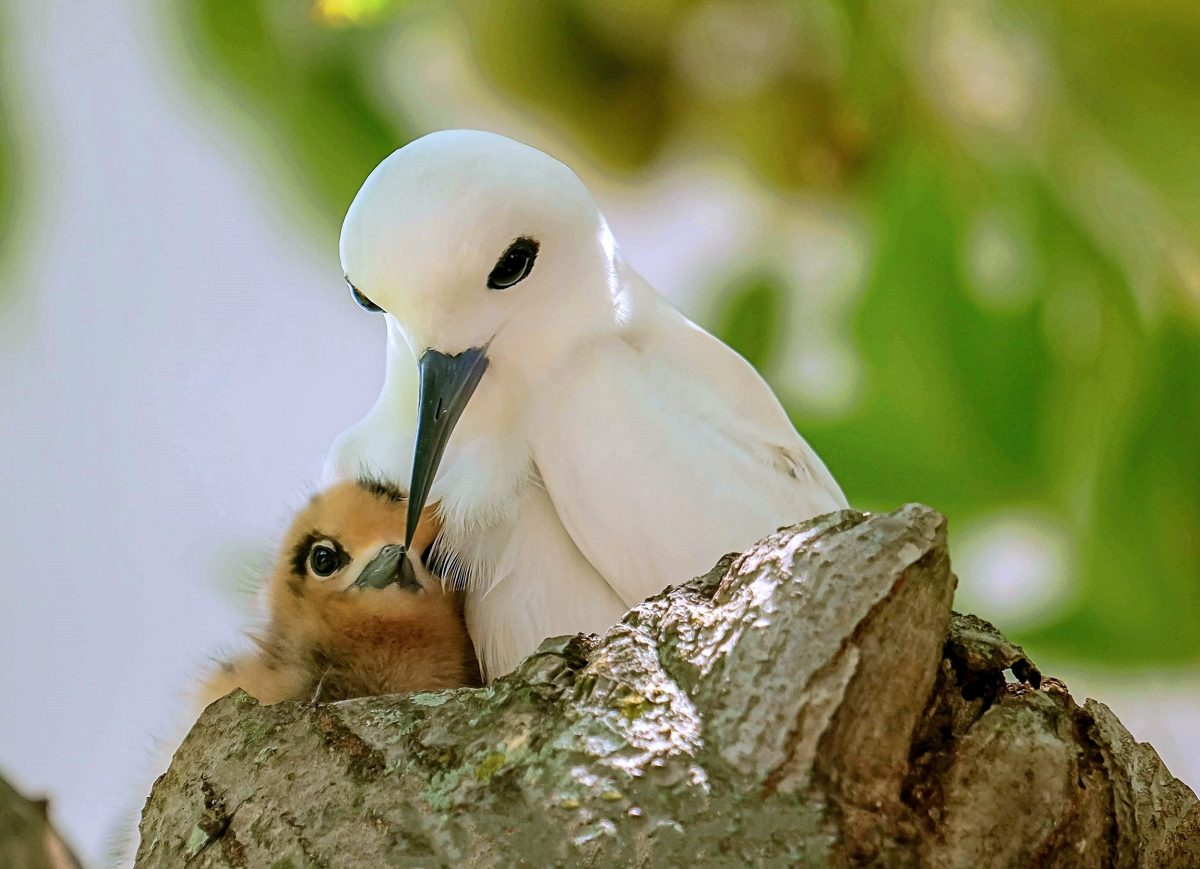
White terns don’t build nests but tend to deposit their eggs in the natural bowls of a tree branch. Here, a parent connects with its one-week-old chick at their nesting spot.
Downs, a former civil servant, became fascinated with white terns after retiring in 2014. He volunteered to help VanderWerf document every white tern nesting spot for the state. VanderWerf’s official survey ended that year; Downs hasn’t stopped collecting data.
In 2016, he cofounded, and now directs, a white tern fan group called Hui Manu-o-Kū. One of the group’s initiatives is to carry out white tern monitoring. Downs set up an online database that allows anyone with a phone to record an occurrence of nesting white terns. A couple of members submit nesting observations every week, at least a dozen report nesting observations every few weeks, and more than 100 have submitted nesting observations once or more. “Now hardly a week goes by that a new person doesn’t submit an observation using our tools,” says Downs.
He remains the data-gathering king of the bunch. Before the COVID-19 pandemic, he double-checked every report that arrived from the fan group and visited an average of 1,200 nesting spots a month. He has recorded or confirmed more than 1,800 in more than 1,200 trees in the city. It takes him as little as two minutes to analyze a site and enter observations in his database. But he’s not always rushing; once he returned a fallen chick to a branch and waited until its parent returned—seven hours later—to make sure it was safe. “They’re choosing to live right here amongst us,” Downs says. “It would be a shame if we didn’t understand them in depth.”
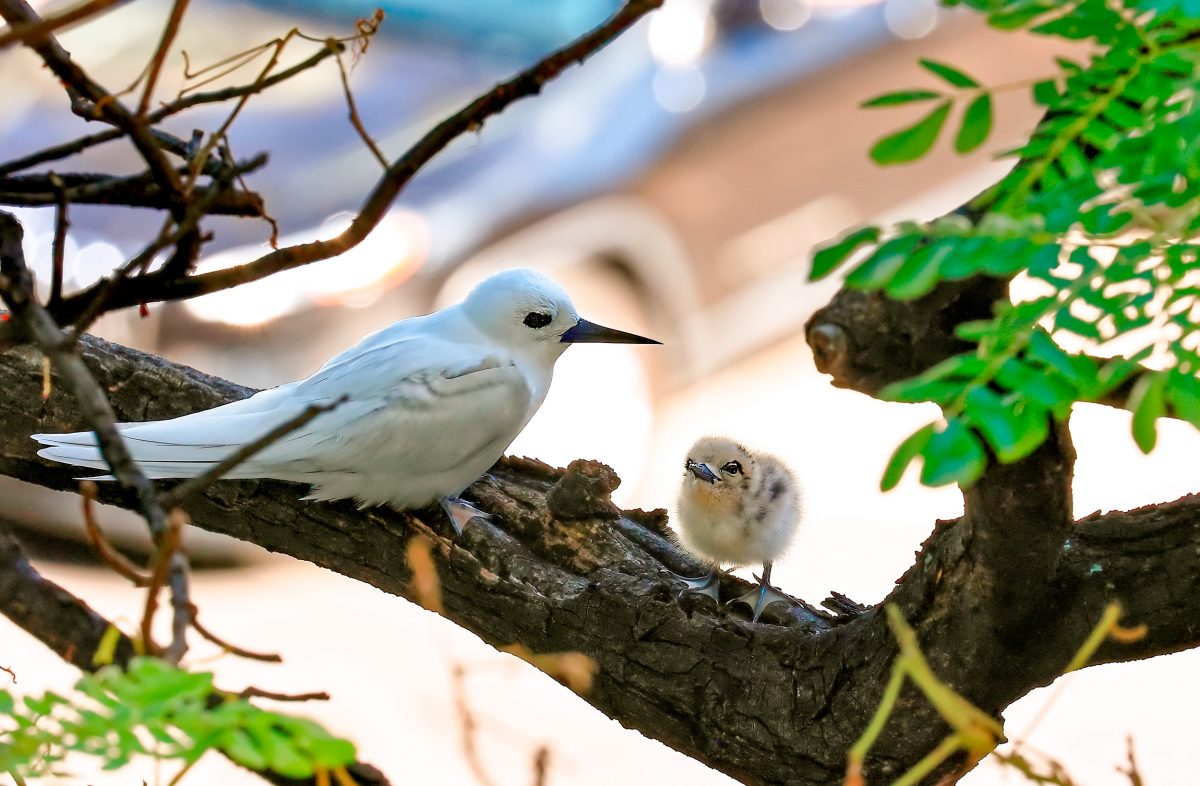
A white tern adult and its chick perch on their nesting branch above one of the busiest streets in urban Honolulu.
The data the group has gathered over the years has provided insights into the white terns’ breeding and nesting habits, VanderWerf says. It has helped answer basic questions, including how many white tern eggs hatch (69 percent) and how many chicks parents raise annually (as many as three). VanderWerf and Downs collaborated on a scientific paper reporting these results and are working on another about the factors that affect breeding success.
VanderWerf believes the white tern population in Honolulu will likely continue to grow because it’s still at a relatively low density and parent birds seem to be successful at finding fish nearby for their chicks. For the terns to have a good chance of spreading beyond Honolulu to other sites in the main Hawaiian Islands, predators have to be contained, he adds. “One of the most important things that has to happen is that we need greater awareness that nonnative predators, especially rats and cats, are a threat to seabirds and other birds, too. And we need greater public support for controlling their numbers.”
In Honolulu, Downs and VanderWerf have seen the community rally around the terns. The city has embraced the seabird, partly because of its role in Hawaiian culture. Adult white terns hunting for their chicks keep small fish in their beaks during the flight home. Polynesian seafarers who navigate using traditional methods based solely on environmental cues follow white terns with fish, knowing the birds are returning to land to feed their young. It was the mother of a revered Hawaiian navigator who, in 2007, successfully pushed to make white terns the official bird of Honolulu. In 2016, several state and conservation organizations started collaborating on an annual festival to celebrate the bird.
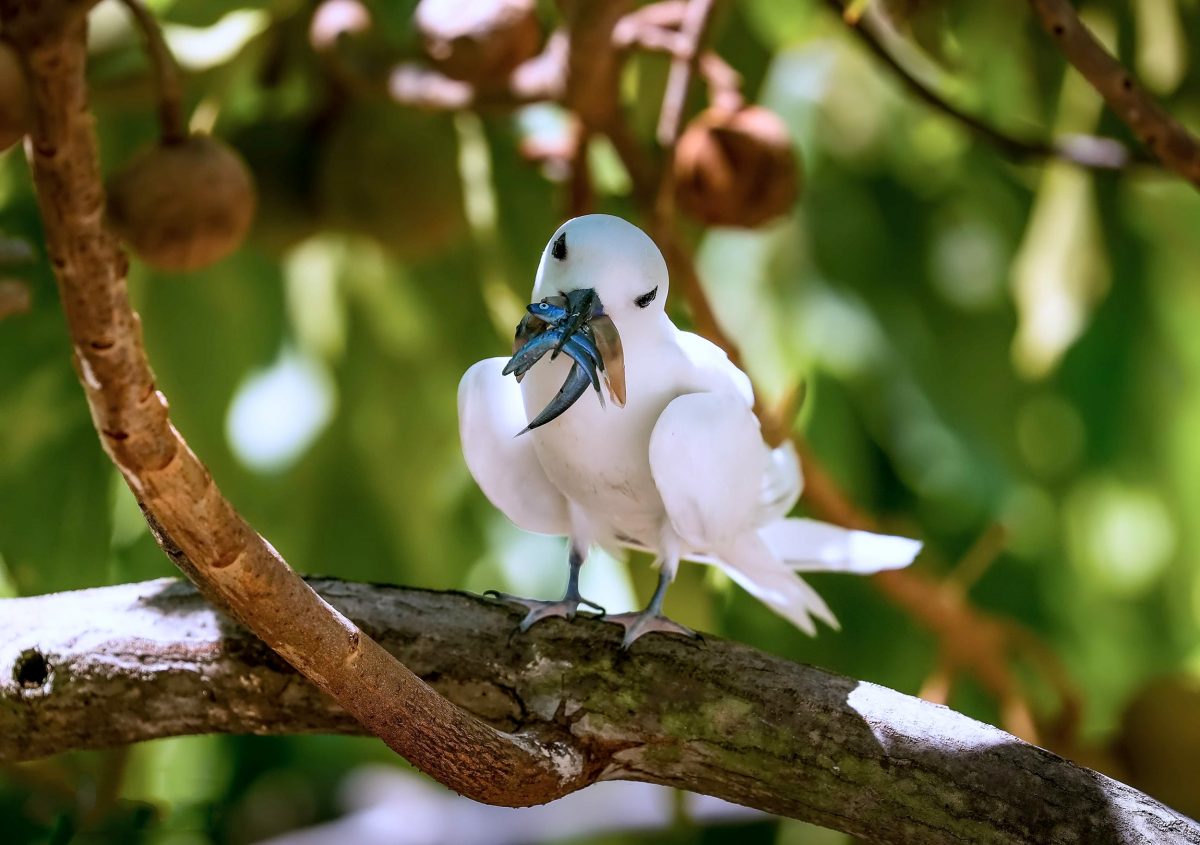
A white tern returns to its nesting tree with a beak full of fish caught out at sea to feed a newly fledged chick. Parents sometimes wait hours for their offspring to come back to the nesting spot for a meal.
Scientists, vets, students, arborists, and an assortment of volunteers are all doing what they can to help study or care for Honolulu’s signature bird. Many of them recognize that the city’s white terns offer something truly unusual—a golden opportunity to closely care for and understand a native seabird in a state that is losing other native species at an alarming rate. Hawai‘i is the endangered species capital of the United States. More than 270 species have gone extinct since Europeans first visited the islands in 1778, according to Hawai‘i’s Bishop Museum. In the main Hawaiian Islands alone, the US Fish and Wildlife Service lists 537 threatened or endangered species—the highest number for any state. At least 19 species of birds—possibly as many as 30—have gone extinct on the main Hawaiian Islands over the past 243 years.
“We are a good news story,” says Wendy Kuntz, a math and sciences professor at the Kapi‘olani Community College who has her students study white terns on campus and contribute to Downs’s database. “They are few and far between.”
In the heart of the Honolulu Zoo, in a two-meter-high black cage, a tennis-ball-sized puff of white down with big, shiny black eyes perches on a branch just above the ground. Outside the cage, Marlee Breese, dressed in a tan Hawaiian shirt with pink and yellow flowers, takes a small vitamin and stuffs it down the throat of a thawing five-centimeter-long fish called a lake smelt. She places the fish onto one end of a wooden kebab skewer and enters the cage. “Are you hungry?” she asks. Breese extends the smelt toward the chick, which leans forward and swallows the fish whole. She feeds it two more. After each fish, the bird steps around gingerly on its gigantic webbed feet with three hooked claws, evolution’s solution to growing up on a branch instead of a nest.
This bird will eventually fly free again. It’s the 33rd white tern to be rehabilitated by the zoo in cooperation with other wildlife organizations since 2018 (and the tally has grown since my visit). The effort is just one example of how different groups have rallied around the species to help every individual. Arborists are playing a role, too. At least 20 in Honolulu have been trained to trim trees used by terns, after the Aloha Arborist Association, government agencies, Pacific Rim Conservation, and Hui Manu-o-Kū came together to develop guidelines. The arborists learned to look for terns before cutting, to use the online database to bring up photos of a nest spot if there is a blue ribbon tied around a tree, to give the birds enough space so that they won’t be disturbed, and to report new nesting locations using the database. If a chick falls out of a tree—strong winds and storms may blow youngsters off precarious perches—citizens call the hotline on the blue ribbons and Downs springs into action. He often calls arborists, who may climb trees several stories high to put the birds back. Downs uses the photos he took doing surveys to guide arborists to the exact nesting spot in each tree, which is important: if a young chick is returned even a meter away from its original nesting spot, the parents might not care for it anymore.
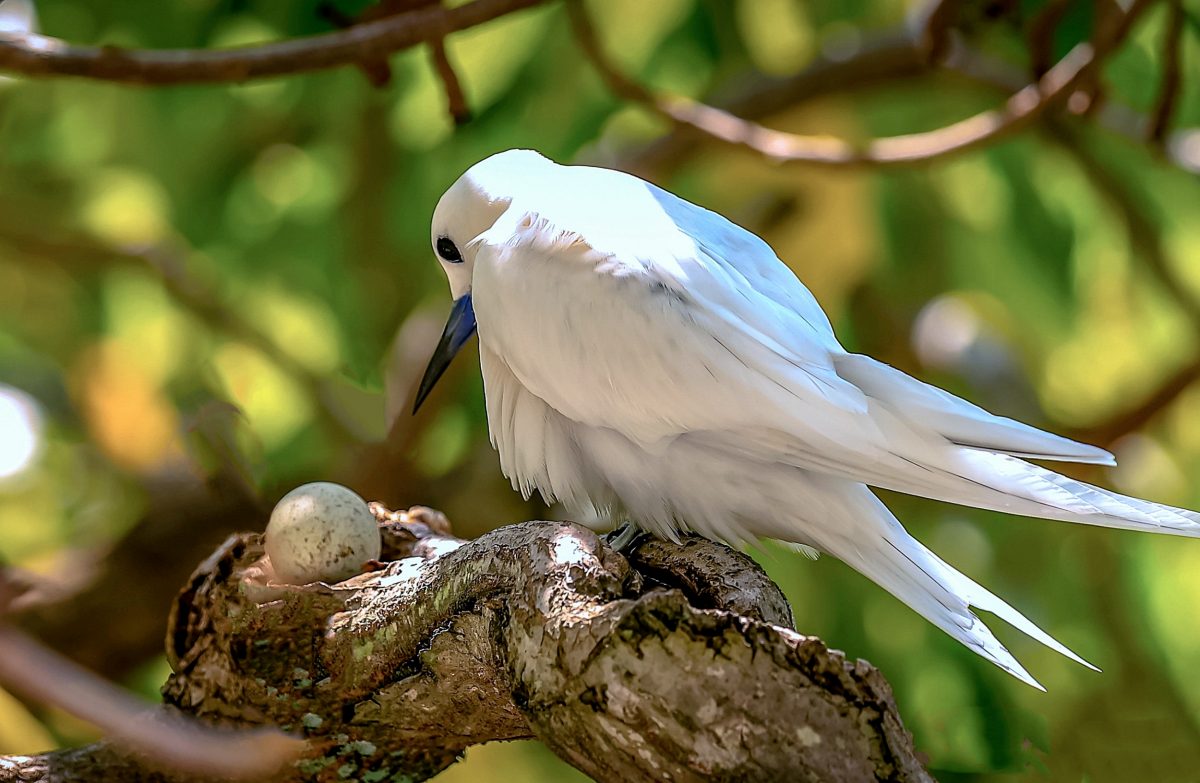
White tern parents take turns incubating their single egg and raising the chick once it emerges. Here, a parent prepares for an egg-tending shift, which will include rotating the egg with its claws and then settling on top of it to keep it safe and warm.
This chick’s path to the zoo was typical of rescued white terns. It had fallen out of a tree in Honolulu. When rescuers tried to put it back, it fell again. So it went to a veterinarian on the east side of O‘ahu. After an initial assessment, it was flown to the Hawai‘i Wildlife Center on the Island of Hawai‘i, which rehabs injured native seabirds. Staff conducted a neurological exam and found that the bird had signs of head trauma. Over the course of several days, staff cared for the bird, tested its mobility, watched to make sure it could hang on to a branch, and then put it on a plane back to O‘ahu, where it was taken to the Honolulu Zoo.
After Breese finishes feeding the chick, she grabs a bamboo pole taller than she is and walks to a tree not far from the cage. As the executive director of the Honolulu Zoo Society (since retired), this isn’t her usual job. On this prepandemic morning, she’s filling in for one of 11 volunteers who normally feed the birds three times a day. Breese puts a smelt in a hole at the end of the bamboo pole and extends the fish up to a white tern perched on a branch above her head. The young bird spreads its wings, bends down, and snatches the smelt. In a few weeks, this chick, which recently graduated from the cage, will follow adults flying overhead to hunt over the open ocean.
For now, it wobbles around its temporary home with a stomachful of fish, a satisfied example of how Downs’s online database and corresponding blue ribbons are not only for data collection and awareness, respectively, but also function together as a conservation tool that allows fallen seabirds to be rescued and rehabilitated by a menagerie of concerned citizens.
Early on a Saturday morning, Downs ushers 15 people from tree to tree in Waikīkī, Honolulu’s bustling tourist district, as he leads one of Hui Manu-o-Kū’s free monthly walks. Downs views white terns as gateway birds. After getting people to care about them on a walk, he shares the threats other native birds face. “I do have people say [they] learned about terns first and then got involved with other birds,” he says.
Necks arch back and phones and cameras go up as Downs points out white terns. At a tree next to the pink Royal Hawaiian Resort, he takes out his tablet and shows everyone a map in Google Earth connected to his database with all of the documented nest sites in Honolulu. “Wow,” someone responds. A woman in a gray-and-white visor inquires how far the birds venture out to sea. Downs doesn’t have an exact answer yet but is hoping satellite tags get small enough for white terns to carry so that he and VanderWerf can learn more about their travels.
As a middle-aged man with a Harley-Davidson backpack takes photos, a woman in a gray tie-dyed shirt says she once saw a white tern chasing a frigate bird, a large black seabird that sometimes preys on other seabirds’ chicks. Downs listens intently and then leads the group past a Jimmy Choo store and up an escalator for shoppers at the Royal Hawaiian Center for a view of a chick in a nesting spot that’s been used four times in the past three years.

Downs leads a group on a white tern educational walk in downtown Honolulu. Photo courtesy of Rich Downs
Next, he heads across busy Kalakaua Avenue and through an entrance between a Tesla showroom and a Rolex shop. This is the International Market Place, an outdoor mall with more than 80 shops. It’s close enough to the beach that people can smell the ocean and is bustling with so many tourists that constant chatter fills the air. Daily foot traffic hovers between 52,000 and 80,000 people. In the middle of the open air market grows an Indian banyan tree that’s roughly 160 years old and the height of two telephone poles. Banyans are one of the species white terns favor, and this particular tree boasts 24 nesting spots and is worth US $10-million a year. Arborist Steve Nimz came up with that amount by adding up the tree’s square footage and estimating how much the mall would receive for rent each year if the tree was cut down in favor of retail space. The mall was rebuilt less than 10 years ago, but the nonnative tree was allowed to hold its valuable ground.
Downs leads his followers up an escalator to the second floor to point out white terns, along a second-floor walkway to show them a former nesting spot on a branch, and up another escalator to a spot near a third-floor railing with views of more terns. He brings out his tablet and shows everyone how to enter a new sighting in his database.
On a thick branch three stories high and a few arm lengths away from the railing sits a downy white tern chick, whose parents decided the best chance for its survival was in a tree decorated with lights in the middle of one of the busiest shopping centers in Hawai‘i. As ethereal adults fly overhead and dozens of tourists pass by, the chick with pretty black eyes sits mostly still, a fluffy little ambassador at home in the eye of a hurricane of extinction.

